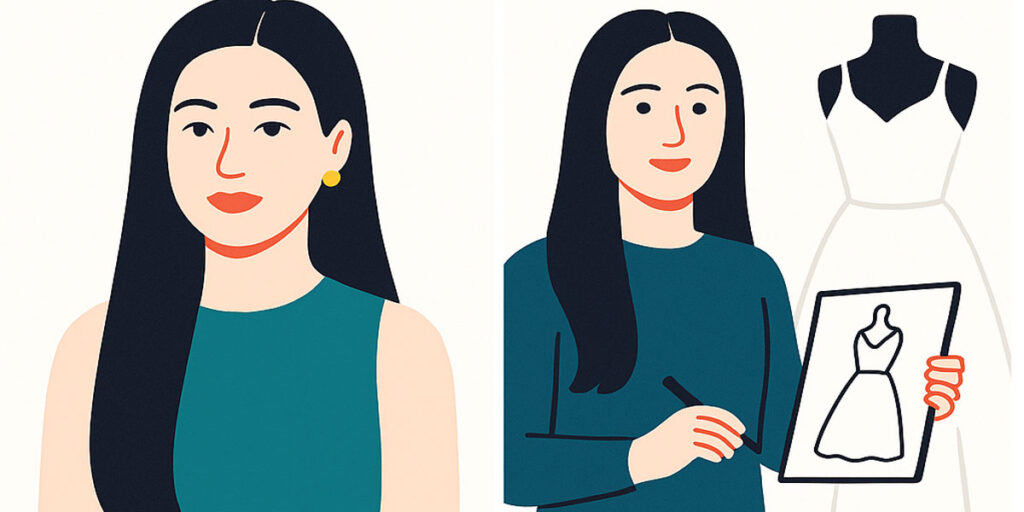In the world of high fashion, there are few names as gracefully stitched into the fabric of modern style as Vera Wang. Her name is now synonymous with elegance, sophistication, and bridal dreams. But before her gowns walked down aisles and graced runways across the globe, Vera’s story began in the bustling heart of New York City, where ambition and artistry met in a young girl’s heart.
Vera Ellen Wang was born into a family that appreciated beauty, grace, and tradition. Her parents were immigrants from China who had built a strong life in America. Her father was a successful businessman, and her mother, who worked at the United Nations, had a remarkable sense of style. It was her mother who first introduced Vera to the world of fashion—shopping trips, fashion magazines, and glimpses of runway shows played like soft background music in her upbringing. From a very young age, Vera felt the pulse of fashion beneath her skin, but she had no idea that one day she would change the very shape of it.
Before Vera picked up fabric and thread, she laced up her ice skates. Figure skating was her first love. She trained rigorously, dreaming of Olympic gold. Skating taught her about movement, flow, and elegance—all qualities that would later define her designs. But when she failed to make the U.S. Olympic team, her dream shifted. The disappointment was real, but it didn’t break her. Instead, it became part of her drive, a lesson in resilience that she would carry into the fashion world.
Vera studied at Sarah Lawrence College, where she majored in art history. Her creative spirit had always needed space to breathe, and she found joy in the beauty of visual storytelling. After college, she stepped into the legendary fashion magazine Vogue, where she started as the youngest editor in the publication’s history. For seventeen years, Vera lived in the world of glossy pages, runway glamour, and style revolutions. She worked with the best designers, learned the business of fashion, and sharpened her own vision of beauty. She absorbed everything—how fashion was more than just clothing; it was emotion, identity, and expression.
But something inside her still felt incomplete. After nearly two decades at Vogue, Vera moved to Ralph Lauren, where she spent a couple of years learning the craft of design firsthand. Yet, it wasn’t until her own wedding that destiny finally tapped her shoulder.
As Vera planned her marriage, she searched high and low for the perfect bridal gown. But nothing spoke to her. Everything felt too traditional, too stiff, too predictable. And then, like a thread pulling through silk, the idea appeared—what if she designed her own dress?
She did.
And not only that, but she discovered a wide-open space in the fashion world that she was born to fill.
In 1990, at the age of 40, Vera Wang opened her first bridal boutique at the Carlyle Hotel in New York City. It was a bold move, and some doubted her. The bridal industry, at that time, was a rigid space with very defined norms. But Vera saw it differently. To her, a wedding gown wasn’t just a piece of tradition—it was a statement of identity. It was art wrapped around emotion. She designed gowns that flowed like dreams, whispered elegance, and embraced modern women with confidence and freedom.
Her designs broke the mold. She combined the structure of high fashion with the softness of romance. The world noticed. Brides started flocking to her store. Celebrities, socialites, and dreamers alike wanted to walk down the aisle in a Vera Wang.
What made Vera different was not just her fabric or silhouettes—it was her philosophy. She didn’t believe in forcing women into a mold. She believed in bringing out their essence. Every dress she made was designed to enhance the uniqueness of the woman wearing it. And slowly, dress by dress, wedding by wedding, Vera Wang became a symbol of personal elegance.
Her empire expanded quickly. She began designing not only bridal gowns but also eveningwear, ready-to-wear collections, fragrance, jewelry, and home products. Every piece carried her signature—delicate yet strong, graceful yet bold. From Hollywood red carpets to Olympic figure skaters’ costumes, her work spanned across industries and inspired millions.

But what truly marked Vera’s legacy wasn’t just the success. It was her fearless reinvention. She showed the world that starting a new journey at 40 wasn’t late—it was just right. She proved that success doesn’t always arrive at twenty or thirty; sometimes, it waits for the right moment, the right idea, the right spark.
She built her brand not just with talent, but with discipline and humility. She often spoke about the hard work, the pressure, the late nights, and the need to continuously evolve. Fashion was not static, and neither was she. Her creativity never stopped growing. Vera embraced technology, reached out to new generations, and made her name accessible through collaborations with stores like Kohl’s. She created luxury that could speak to different types of women—those who dreamed big, worked hard, and wanted their moment to shine.
Her impact on bridal fashion was nothing short of revolutionary. Before Vera, wedding gowns were often variations of the same script—white lace, poofy sleeves, and cookie-cutter shapes. Vera gave brides permission to be themselves. She introduced bold blacks, soft grays, and touches of nude and blush into her collections. She used layers, asymmetry, modern minimalism, and even edginess—all in a world that had clung tightly to tradition.
Yet, despite the glamor, Vera always kept her work grounded in meaning. She never forgot that her dresses were a part of people’s most important memories. She honored that responsibility with great care. Every design carried a story. Every gown was crafted with passion.
Through all of this, Vera also remained a powerful voice for women in business. She was one of the few Asian-American women leading a global fashion brand, and she opened doors for many who followed. She mentored young designers, supported fellow entrepreneurs, and kept her values at the center of her empire. Her presence, both elegant and powerful, became a model of leadership with grace.
Her journey was never about fame—it was about expression, craft, and connection. Vera once said that she was not a “natural designer.” That may be true in a technical sense, but her talent bloomed from a deeper place. She understood the emotional language of clothing. She knew how to transform fabric into feeling. She believed that fashion was not just about looking good, but about feeling confident, powerful, and beautiful from the inside out.
As the decades passed, her name continued to evolve into something more than a brand. It became a symbol. A Vera Wang gown meant more than elegance. It meant daring to be different. It meant rewriting your story at any age. It meant believing that creativity has no expiration date.
Even in her later years, Vera didn’t slow down. She kept experimenting, launching new lines, exploring new materials, and connecting with younger audiences. Her Instagram presence became a surprise hit—fans were delighted to see her in bold looks, youthful energy, and unapologetic style. She didn’t just follow trends; she helped create them.
In a world that often rushes people into timelines—when to succeed, when to peak, when to settle—Vera Wang stood as a graceful contradiction. She reached her creative breakthrough at 40, became a fashion icon in her fifties, and continues to inspire across generations. She taught the world that fashion is not just about age or fame—it’s about voice, vision, and the courage to create something new.
Vera Wang’s story is not just about dresses. It’s about daring to change paths. It’s about embracing your culture, your setbacks, and your own sense of beauty. It’s about creating a world where elegance is personal and every woman, no matter who she is, can feel like she’s wearing magic.
She took her dreams and sewed them into reality, one stitch at a time. And in doing so, Vera Wang didn’t just design dresses—she designed hope, self-expression, and a timeless sense of grace that continues to shape the world of fashion today.
